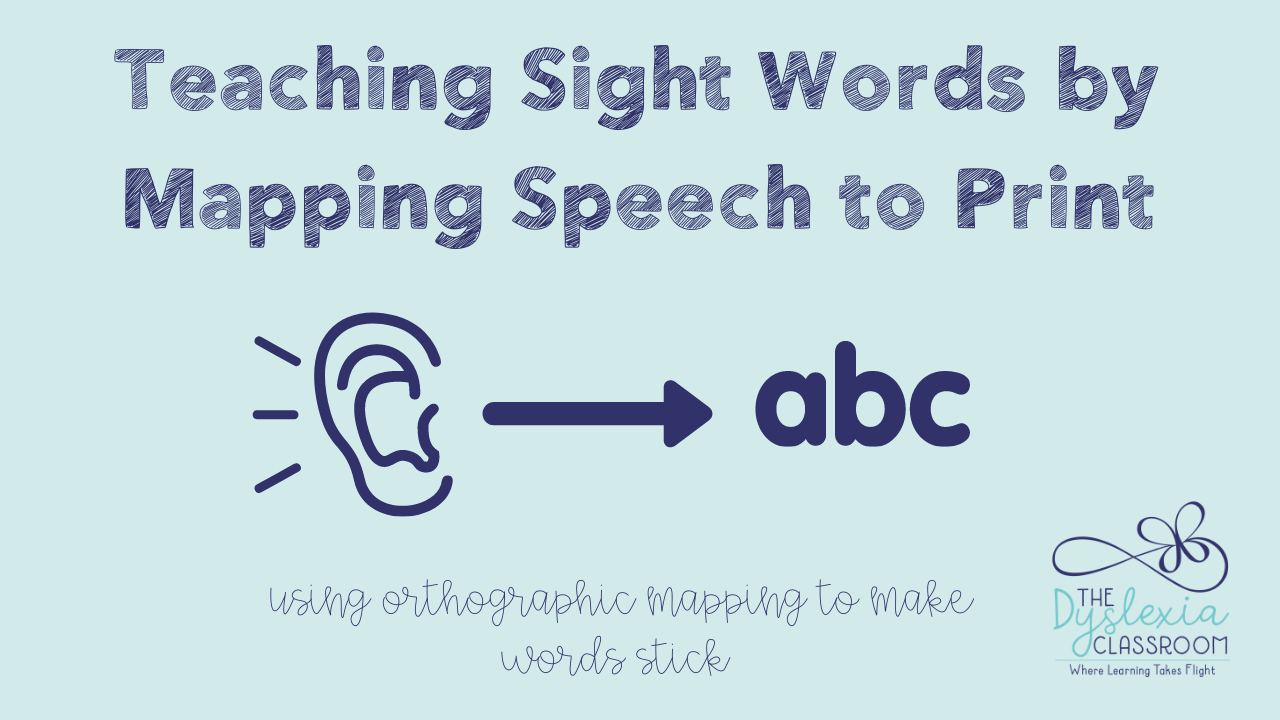Teaching Sight Words by Mapping Speech to Print

In the education field, the term sight word is used to represent many different things based on who is talking and their training and pedagogy. For some, sight words are synonyms for high-frequency words. For others, it refers to words that they consider irregular or rule breakers and are considered words to memorize. Then there are those who refer to sight words as any word that is read automatically. I fall into the latter category and refer to sight words as instant words or words that we know by sight.
I first began my teaching journey well over two decades ago. At that time, my college peers and I were taught to teach our students to memorize sight words. We also explained to our students that English spellings were unpredictable.
I then transferred to a school that used Siegfried Engelmann's Direct Instruction which directed that all words, regardless of irregular spelling and pronunciation, were sounded out. This was my first introduction to helping students connect the sounds of word to print, and was a complete shift from what I had originally been taught.
This strategy was helpful for my students, but I wanted to learn more so that I could explain WHY words were spelled a certain way and why the letter(s) representing those sounds were pronounced differently within certain high-frequency words. Of course, at that time, the research of understanding the reading brain wasn't readily in the hands of the teachers, but this desire to learn more set me on a path to become a structured literacy dyslexia therapist.
I know so much more now yet continue to grow and learn on this journey with understanding the ever evolving science of reading. We know that reading and spelling, or decoding and encoding, are a reciprocal process. We want to help students understand the connection between letters and sounds and sounds and letters, and help them apply this knowledge to both reading and spelling.

What is orthographic mapping?
Orthographic mapping refers to the process that readers use to store written words for immediate and effortless retrieval. When we hear a word, it enters our phonological lexicon. We know that sounds together form a word and carry meaning.
When we map those sounds (phonemes) to letters (graphemes), we form connections between what we hear and what we see. Linking the speech sounds to print is a powerful strategy for students and builds the necessary connections to have those sound-letter combinations become unitized. This word or letter combination is stored in our memory as a unit and is used to read new, unknown words.
The more we solidify these mappings, the more efficiently and automatically we can retrieve and apply them, to reading and spelling. ALL words follow this process, and once learned, all words become sight words. When I shifted my instructional practices to focus on speech to print, it made so much sense! No more memorizing words!
What does this mean?
How we teach the reading and spelling of words, especially those considered high-frequency or irregular sight words needs to be changed. No more telling students to memorize words. Instead, we can take that strategy that I learned oh so long ago, revamp it, expand on it, and connect it to the current research.
Here is a quick overview of how I teach my dyslexic students high-frequency sight words. I address orthographic mapping with my students to help them connect speech to print in a systematic way that incorporates a gradual release of responsibility. I also like to include the history of our language (etymology) and spelling generalizations.

Let's say we are introducing the high-frequency word from. First, you would have students say the word without looking at any print. The goal is to move from speech to print.

Next, have students segment the sounds in the word by tapping each sound by using their fingers or manipulatives such as pom-poms, erasers, or square tiles to represent each phoneme. This is done without looking at the word yet. If you teach speech to print using the Orton-Gillingham approach or a dyslexia therapy model, you may want to write the sound representations on the board, as are seen in the card below.

Then we write the word from and we map, or connect, the sound to the letters. You can see how this is done on the card above. I use the history of the English language and spelling generalizations to help students understand why a sound-letter correspondence may be irregular. My students are inquisitive and enjoy learning the reasons behind why words are spelled certain ways. This approach has led them to become more analytical in their reading and spelling of words, which I love!

I hope this glimpse of how I map sounds to print has helped you understand a little more about how teaching methods for sight words/high-frequency words have evolved in the area of reading instruction.
Did you find the orthographic mapping lesson of the word from helpful? I also have a product that I have created that will help students anchor learning and can be used as reference charts in both reading and spelling application. The cards are designed to help you differentiate your instruction, provide you with the historical reasons behind what are considered "irregular", and provide you with quick references for spelling generalizations. It also lets students see how sounds link to letter representations. Click here to read more about the product. Let me know if you have any questions.
I hope you have a great week!
Casey @ The Dyslexia Classroom

This information is the intellectual property of @2016 The Dyslexia Classroom®. Do not use or repurpose without expressed permission from The Dyslexia Classroom®. Please email [email protected] for permission, and give The Dyslexia Classroom® an attribution if you use, reference, or quote/paraphrase copyrighted materials. This includes but is not limited to blogs, social media, and resources.




